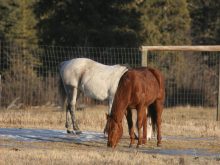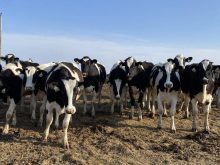Hopefully the rains will come for your area this spring and it won’t be long until we are turning cow-calf pairs out to green pastures.
In many herds, as part of spring turn-out, calves will get processed and vaccinated for clostridial disease and some respiratory diseases as well. As part of processing, sometimes painful procedures are necessary, such as castration, dehorning and branding.
We have solid scientific evidence that pain control products provide benefits to calves when they undergo procedures such as castration and dehorning.
Read Also

Why selenium is still an important factor in horse health
Selenium is an essential equine trace mineral that supports antioxidant defense, muscle integrity, immune function, metabolism and thyroid activity.
We have a lot less scientific evidence on how effective pain control drugs, such as non-steroidal anti-inflammatory drugs, are when calves are branded.
Branding is becoming less common across the beef industry. However, it is still used as a permanent form of identification to mitigate issues with stolen or lost cattle and to provide a permanent method of establishing ownership, especially in certain areas of Western Canada.
The National Beef Quality Audits in Canada have shown that the number of cattle with brands coming through the slaughter plants has dropped from 50 percent to 12.6 percent between 1998 and 2016. I expect our next beef quality audit will show an even further drop the next time it is carried out. As a result, the losses in terms of hide damage have decreased substantially to about $3.1 million in 2016-17.
We know branding is painful for calves, regardless of the technique used. Research by Dr. Karen Schwartzkopf-Genswein (Agriculture Canada, Lethbridge) as part of her PhD thesis, demonstrated that hot iron branding is somewhat more painful than freeze branding.
In this article, I want to share some results from a recent paper published in the Journal of Animal Science, which examined the use of oral meloxicam in yearling beef cattle to evaluate if it provided relief from pain.
The study was carried out by researchers at Kansas State University and Colorado State University. The researchers used 70 yearlings (820 pounds) for the study consisting of 35 steers and 35 heifers. The yearlings were Angus, Herefords or Angus-Hereford crosses.
The cattle were randomized to receive a nonsteroidal anti-inflammatory drug in the form of oral meloxicam or they received a placebo that contained no active ingredient.
All the cattle were then hot branded on their left hip. It’s interesting to note that here in Canada we have meloxicam available both in an oral suspension and injectable form and it has been a licensed product for pain control in cattle.
Pain in animals is difficult to measure and researchers used many different techniques to evaluate pain after branding. They collected multiple blood samples up to 48 hours after branding to assess serum cortisol (the pain hormone) and another biomarker associated with pain known as prostaglandin E2.
They also assessed hair cortisol in the animals at baseline and at day 30 post branding. They used a technique known as infrared thermography to assess heat at two sites: the branding site and the animal’s eye.
They measured the animal’s response to pressure at the branding site using a special instrument known as an algometer. Researchers also measured the animal’s behaviour using accelerometers attached to their left hind legs, which allows them to measure standing and lying time and they evaluated visual behavioural aspects of pain such as tail swishing, head carriage and foot stomping. Finally, they scored the wounds associated with the branding site weekly for 12 weeks after branding.
What did they find out about branding and the use of meloxicam? Researchers emphasized that there was no doubt that branding was painful. All the measurements they used to evaluate pain clearly showed that branding caused pain.
The study also demonstrated that there were differences between breeds and between steers and heifers that were obvious in many of the biomarkers of pain that they measured.
Finally, researchers demonstrated that meloxicam did reduce the infrared thermography scores and reduced the cattle’s bouts of lying down for 12 hours after branding, which suggests that meloxicam did have some benefits in reducing pain after branding.
We’ve heard anecdotal evidence from cow-calf producers in Western Canada that would support the claim that the use of a non-steroidal anti-inflammatory drug such as meloxicam has a beneficial effect on calves post-branding.
Many producers who use products such as meloxicam say calves mother up more quickly and move better when turned out post-branding.
In my experience, once producers adopt the use of pain control products, they usually continue to use them because the benefits are obvious.
The bottom line is that branding is indeed painful for any age of animal and this pain probably lasts several weeks at least.
This study evaluated branding in older animals and the effects on younger calves may differ.
Meloxicam probably only has effectiveness for 48 hours, and it is unlikely to completely alleviate all the pain associated with this procedure.
Unfortunately, we also don’t have access to any sort of practical method of controlling the acute pain during the branding process.
There are undoubtedly some situations where branding is still a necessary form of permanent identification in the beef industry, but we should only use it where necessary and when there is no other option.
This study does show that meloxicam at the time of branding does provide some benefit of pain control post-branding, but it certainly would be helpful to have some other methods of analgesia to use in combination with products such as meloxicam when branding is necessary.
John Campbell is a professor in the department of Large Animal Clinical Sciences at the University of Saskatchewan’s Western College of Veterinary Medicine.















